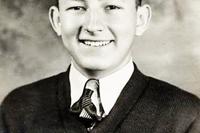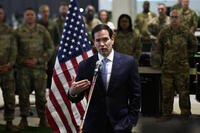Adm. John M. Richardson was chosen Wednesday to succeed fellow submariner Adm. Jonathan Greenert as the next chief of Naval Operations (CNO) in a sign of the Pentagon's commitment to the expensive replacement program for the Ohio class ballistic missile submarines.
Defense Secretary Ashton Carter said he had recommended the 55-year-old Richardson to the White House and President Obama had agreed to nominate him to become the Navy's top officer and a member of the Joint Chiefs of Staff (JCS). There was no immediate word on when Senate confirmation hearings for Richardson would begin.
Carter said that Richardson, currently director of the Naval Nuclear Propulsion Program, was the "clear choice" to become CNO, calling him a "go-to officer for many of the Navy's tough issues."
Carter cited Richardson's work on the Ohio replacement program and "his handling of problems of integrity and ethics."
The reference to "integrity and ethics" included the admiral's leadership and connection to three high profile investigations that have rocked the Navy – the Navy Yard shooting, the Fat Leonard scandal, and the nuclear reaction cheating scandal.
Richardson led a Consolidated Disposition Authority (CDA) in the Navy's dealings with Glenn Defense Marine Asia (GDMA) and its chief executive, Leonard Glenn "Fat Leonard" Francis, which issued a wide range of bribes for Navy contracts.
Richardson eventually cleared Adm. Samuel Locklear, head of the Pacific Command, whose retirement was put on hold while the CDA deliberated. However, the CAD issued a censure of three, two-star rear admirals for their involvement with GDMA.
Following the Navy Yard shooting in 2013, Richardson led the Navy's Manual of the Judge Advocate General (JAGMAN) investigation into the incident and the service's response to the tragedy.
Richardson also oversaw the investigation into the sailors who were found to be cheating on a training test dealing with Navy nuclear reactors.
As head of Naval Nuclear Propulsion since November 2012, Richardson has been heavily involved in the program for replacing the Ohio-class submarines, which carry Trident nuclear missiles and form a leg of the nation's nuclear triad.
Richardson also oversaw the investigation into the sailors who were found to be cheating on a training test dealing with Navy nuclear reactors.
Under current schedules, the first Ohio replacement is scheduled to begin construction in 2021 and enter service in 2031. The replacements are estimated to cost at least $4 billion and possibly as high as $8 billion, compared to the Ohio-class submarine's cost in 2011 dollars of about $2.9 billion.
Navy leaders and Congress have worked to create a controversial separate funding line to build the next generation Ohio-class submarines. Navy officials have said the service would not be able to afford the program if they had to fit it under the service's ship building budget.
Carter made the Richardson announcement at a brief Pentagon ceremony at which he also announced his choice of Army Gen. Mark Milley to replace Gen. Ray Odierno as Army Chief of Staff.
Richardson and Milley joined Carter, Odierno, Greenert, Joint Chiefs Chairman Gen. Martin Dempsey, Navy Secretary Ray Mabus and Army Secretary John McHugh at the announcement. Only Carter spoke and he took no questions from reporters.
Mabus later called Richardson "one of our finest officers. I have great confidence that he is the right leader for our Navy." Greenert, who will retire this fall, said that Richardson was "an ideal strategic leader to keep our Navy moving forward."
"[Richardson] has the background and experience in dealing with tough challenges combined with expert judgment that will guide our Navy well," Greenert said. "He has played a fundamental role in addressing many of our current and future challenges. I am confident he will ensure our Navy's seapower, now and in the future."
Richardson, a 1982 graduate of the Naval Academy with a degree in physics, also holds Masters Degrees from the Massachusetts Institute of Technology, the Woods Hole Oceanographic Institution, and the National War College.
In his career, Richardsond previously served as commander of the submarine USS Honolulu, Submarine Group 8, Submarine Allied Naval Forces South, and as Chief of Staff for U.S. Naval Forces Europe and U.S. Naval Forces Africa.
The choices of Richardson and Milley were the latest moves by the White House in seeking a complete lineup change at the Joint Chiefs of Staff by the fall.
Last week, Obama nominated Marine Commandant Gen. Joseph Dunford to replace Dempsey as JCS Chairman. Marine Gen. John Kelly, now head of U.S. Southern Command, and Marine Lt. Gen. Thomas Waldhauser, currently director of Joint Force Development on the Pentagon's Joint Staff, were considered possible successors to Dunford as Commandant.
Obama also will have to find a new Air Force chief of Staff this fall, when current Air Force Chief of Staff Gen. Mark Welsh is expected to retire.
-- Richard Sisk can be reached at richard.sisk@military.com








